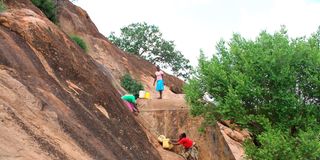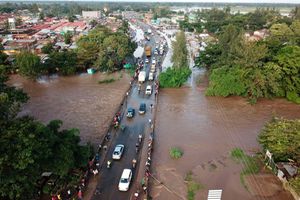How communities are tapping rocks to address water scarcity

Residents of Iviani village, Makueni County, harvest water at Mukononi rock.
What you need to know:
- Mukononi region is not served by any river. It receives erratic rainfall, making it one of the driest regions in Makueni County.
A year after beating hundreds of young traders across the country in a business competition dubbed ‘Plug Mtaani Business Idea Competition’, Faith Mumo is still over the moon. “It is surreal,” she says of the feeling associated with the victory. Although she has not received the entire Sh250,000 prize money, which was meant for the second runners up, and has launched a complaint with the organisers of the competition, the 30-year-old is glad that she participated.
“The publicity that came with the award has increased our market demand, leading to increased income and creation of more employment opportunities for youth and women,” Ms Muno told Climate Action in Iviani Village, Makueni County, where she operates a vibrant fish farm and a mango orchard. The winning enterprise is hinged on rock catchment water harvesting.
This entails collecting runoff from the surfaces of large rock outcrops using a concrete gutter system set on the edges of the outcrop. Once it rains, the gutter system funnels the collected rain water into a tank at the base of the rock from where it is distributed to the community for various uses. Ms Mumo has tapped a sprawling rock outcrop, which dominates her compound, and has directed the collected rain water into plastic tanks. The fisheries expert has designed a system which ensures that the water harvested from the rock is retained in the fish ponds throughout the year.
“Harvesting rainwater from a rock has enabled our business to thrive because tilapia and catfish thrive in fresh water,” Ms Mumo said.
“We use solar to pump water through a recirculatory aquaculture system that we have improvised using volcanic rocks for aeration and cleaning before pumping it back into the fishponds. The countless pores on volcanic rocks traps solid impurities from the water once it is pumped through them repeatedly. After changing the water, we direct it to the mango orchard for irrigation,” said Ms Mumo, who prides herself as the biggest supplier of fingerlings in the county.
Harvesting rainwater using rocks is turning out to be a key source of water in drylands. Take Mukononi Village in Makueni County, for instance. The region is not served by any river. It receives erratic rainfall, making it one of the driest regions in the county. Mukononi rock catchment water harvesting project, a brainchild of the late Erik Nielsen-Petersen, a Danish water engineer who married and settled in the area in the 1970s while working in a livestock production project undertaken by Danish development agency, Danida, has made life bearable for residents and their livestock. “Mukononi rock is our main source of clean water during the dry season. A 20-litre jerrican costs Sh20,” said Carolyne Musembi, a resident.
According to Robert Kisyula, the head of Kenya Sustainable Transformational and Accessible Water Interventions, a project funded by USAID to build the resilience of vulnerable communities to climate stress and expand economic opportunities through investing in water security in arid and semi-arid counties, using rocks to harvest water underscores the importance of harvesting rainwater as a way of building resilience to climate change.
“Harvesting and storing rainwater should start at the household level using jerrycans and tanks. Multiple studies have shown that an average household can survive on rainwater harvested and stored in a 20,000 tank throughout the year. At the farmlands, farmers use contours and terraces to harvest rain water, enable it percolate and make it available for crops. We use rock catchment systems, sand dams and earth dams to harvest rain water once it goes beyond the farmland level,” Mr Kisyula said recently as he commissioned a solar powered pumping system to facilitate the abstraction of water from a sand dam erected across River Kaiti in Makueni County.
A rock catchment water harvesting system is relatively affordable compared to other water harvesting technologies. It has cost Ms Mumo Sh250,000 to set up a rock catchment water harvesting system which yields 30,000 litres in three rounds of average rainfall. Installing the tanks up on the rock reduces the need for a water pumping system. According to multiple rock catchment water harvesting technicians, transporting building materials up highly inclined rocks and setting up water tanks takes a lion’s share of the cost of production. In case of mega community projects, this cost is highly reduced by involving the local community.
Water sanitation champions concur that it is easier to sanitise rain water collected from a rock compared to sanitising water drawn from a river that is laden with a lot of impurities. A series of check dams on the rock catchment system reduces the amount of solid impurities on the rain water collected. The water is then treated at the point of collection before it is distributed. Technicians recommend routine maintenance of the gutter system and the removal of solid wastes before the onset of the rainy season to enhance the quality of the water collected.
Apart from cushioning communities from biting water scarcity, rock catchment water harvesting systems play a critical role in environment restoration. Mukononi rock catchment water harvesting project sits at the heart of a massive environmental and livelihoods restoration programmes spearheaded by Utooni Development Organization, an NGO that champions the use of local resources in sustainable development. Water harvested from the rock supports an ongoing environmental restoration drive that is aimed at getting the region agriculturally productive. “We are championing the restoration of degraded environments and practising climate smart agriculture. This is key in addressing food and water security,” Nyambura Kamau, the acting CEO at the development organisation, told Climate Action on the sidelines of a recent tree planting exercise around Mukononi rock.
Masue rock catchment water harvesting project, which Makueni County government and the Anglican Development Services set up in 2015 with support from the Department for International Development in the United Kingdom, exemplifies the multiple impacts of such projects. The mega project is the main source of water in the neighbouring community. Until the completion of the project, rain was a curse in the neighbouring community. As it rained, water rushed down the slopes of imposing Masue rock at high speed, causing massive flooding in the neighbourhood and soil erosion, which resulted in gaping gullies. The rock catchment project has since marked the end of flooding associated with the rock that gave the neighbouring community sleepless nights. Ms Mumo is among dozens of individuals who have benefited from lessons on the promise of rock outcrops in addressing water scarcity from the Masue project.


